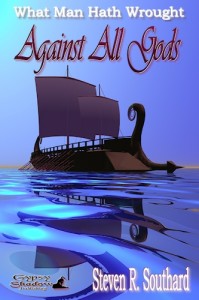In a previous blog post I’ve explored how writers take a basic idea and build it into a story. Here I thought I’d show you that process at work in the development of one of my tales.
 Recently, Gypsy Shadow Publishing launched my story “Against All Gods.” It’s the latest tale in a series called What Man Hath Wrought.
Recently, Gypsy Shadow Publishing launched my story “Against All Gods.” It’s the latest tale in a series called What Man Hath Wrought.
How did I come to write that story? I’ve long been fascinated with ships, ship design, and the beautiful vessels of the past. Among these is the trireme of Ancient Greece and Rome. Well suited for naval warfare in the Mediterranean, triremes sailed and fought for hundreds of years using a basic design that changed little during that time. If Hollywood made a movie featuring the adventures of a trireme crew, I’d stand in line when it opened. Can’t you just see the deadly ram; the painted eyes; the jutting prow; the churning rows of oars; that single rectangular sail; and the graceful, upward curve of the stern?
As an engineer, I’ve also been enthralled by the Seven Wonders of the Ancient World. Using only the simple materials available to them, Bronze Age people of the Mediterranean constructed architectural marvels whose memory lingers across the millennia. Six of the seven are gone, but that only heightens their grandeur, for our imaginations build them anew to a magnificence the originals probably lacked.
How, I thought, could I write a story featuring a trireme and the Seven Wonders? Clearly a sea voyage to each of the Wonders seemed in order. Moreover, it must have some appeal, some relevance, to modern readers who might not share my interests. As to that, it had not escaped my notice that my only previous romance story, “Within Victorian Mists,” had been selling rather well.
Could I manage, then, a tale involving a trireme, the Wonders, and a romance? Time for a mind map to brainstorm various plot ideas. First, all seven Wonders had to be in existence, and since that was only true between 280 B.C. (when the Alexandria Lighthouse was built) and 226 B.C. (when the Colossus of Rhodes collapsed), those dates roughly fixed the story’s timeframe. Early on I abandoned the notion of bringing the woman character along on the voyage as being too far-fetched. That meant my two lovers would be separated for most of the story. And what should the woman do at home while the man voyages on his sea adventure—strum her lyre and pine for him? No. Today’s readers seek strong and independent female characters.
Think, for a moment, about the story you might have written given those constraints. As for me, I explored a few options in my mind map, considering pros and cons of each, rejecting ideas with unsolvable flaws, weighing the remaining notions, and finally selecting the one I believed held the most promise.
As it says in the book blurb, “In ancient Athens, trireme commander Theron and the woman he loves, Galene, have each earned the wrath of jealous gods. To marry Galene, Theron must voyage to all seven Wonders of the World. At every stage the immortal gods test their love with all the power and magic at their command. While Galene suffers anguishing torment in Athens, Theron faces overwhelming challenges at every Wonder from Ephesus to Rhodes to Babylon. Theron and Galene may be devoted to each other, but how can mere mortal love survive…against all gods?”
There it is…a glimpse into the mind of a creative writer at work. Comment if you found it helpful. Or unhelpful. It’s all part of the service provided by—
Poseidon’s Scribe
